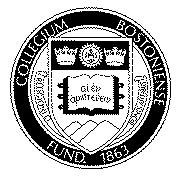
MB 109 Fall 2004
Human Groups at Work
Prof. Steve Borgatti
borgatts@bc.edu; Tel: 978 456-7356; Fulton 220, Tu 1:30-3, http://www.analytictech.com/mb109
 |
MB 109 Fall 2004
|
The topic of this course is groups, especially groups within organizations. Groups are ubiquitous in human social life -- a fundamental adaptation. They are often nested within each other, as when an academic department is nested within a college which is nested within a university which is located in a town which is contained by a state, and so on. Groups can also be cross-cutting, as when a dormitory mixes together students from different colleges. Groups can be formal, as in organizations, departments, teams and so on, but also informal, as in social cliques. Organizations contain a mixture of formal and informal groups, each with their own dynamics.
The principal assignment for this course is a term paper that reports the results of a semester-long research project. The idea is to conduct a comparative study of two or more groups. The groups should be similar in general ways. For example, you could study the difference between the U.S. women's Olympic basketball team, which won the gold medal, and the men's, which did not. Projects may be executed by individuals or as a collaborative effort by a team. I recommend collaborative efforts because it makes data collection quite a bit easier. It is also possible for two or more individuals to collaborate on the data collection, but then turn in separate analyses. Details on the term project are given at http://www.analytictech.com/mb109/termprojects.htm .
There will be an in-class final exam that will consist of mostly short answers and essays. The exam will cover the entire course.
During the semester, students will be asked to provide written summaries of key readings. For details, see http://wwwl.analytictech.com/mb109/write-ups.htm
Finally, students will be graded on class participation. I expect everyone to participate in class discussion and activities. Sharing your real-life experiences as they apply to the discussion will be particularly valuable to the class. Constructive criticism of others' views and genuine listening to others is an important element of class participation. Participation is graded on preparedness, willingness to contribute, relevance, positive attitude, and grasp of the material.
The relative weight of assignments is as follows:
| Assignment | Weight |
| Research Project | 40% |
| Final Exam | 30% |
| Summaries | 20% |
| Participation | 10% |
Important Note: Please submit all written work via e-mail -- no hard copies.
The textbook for this course is Group Dynamics by Forsyth. In addition, there is a book about Salomon Brothers called Liar's Poker. The bookstore also has a book called Soul of a New Machine, which is recommended but not required. There are also a number of journal articles to be read, all of which are available electronically. See the schedule (below) for more information.
Please note that in general the readings do not duplicate class lectures. In other words, I often cover certain topics in class precisely because they are not in the textbook, and vice-versa.
The schedule of assignments and readings is online at www.analytictech.com/mb109/schedule.htm. Please note that the schedule changes throughout the semester to reflect the needs and interests of the class. That's one of the key benefits of having it online. It is therefore your responsibility to check the online schedule constantly -- at the very least once a week, but I recommend more often. Do not print it out once and assume it is valid for the rest of the semester. You have been warned!
You should always feel free to email me (borgatts@bc.edu) and to call me at home (978-456-7356, after 9am and before 10pm). I often work at home, so it is not an imposition to call me there.
| Copyright ©2004 Stephen P. Borgatti | Revised: September 15, 2004 | Home Page |